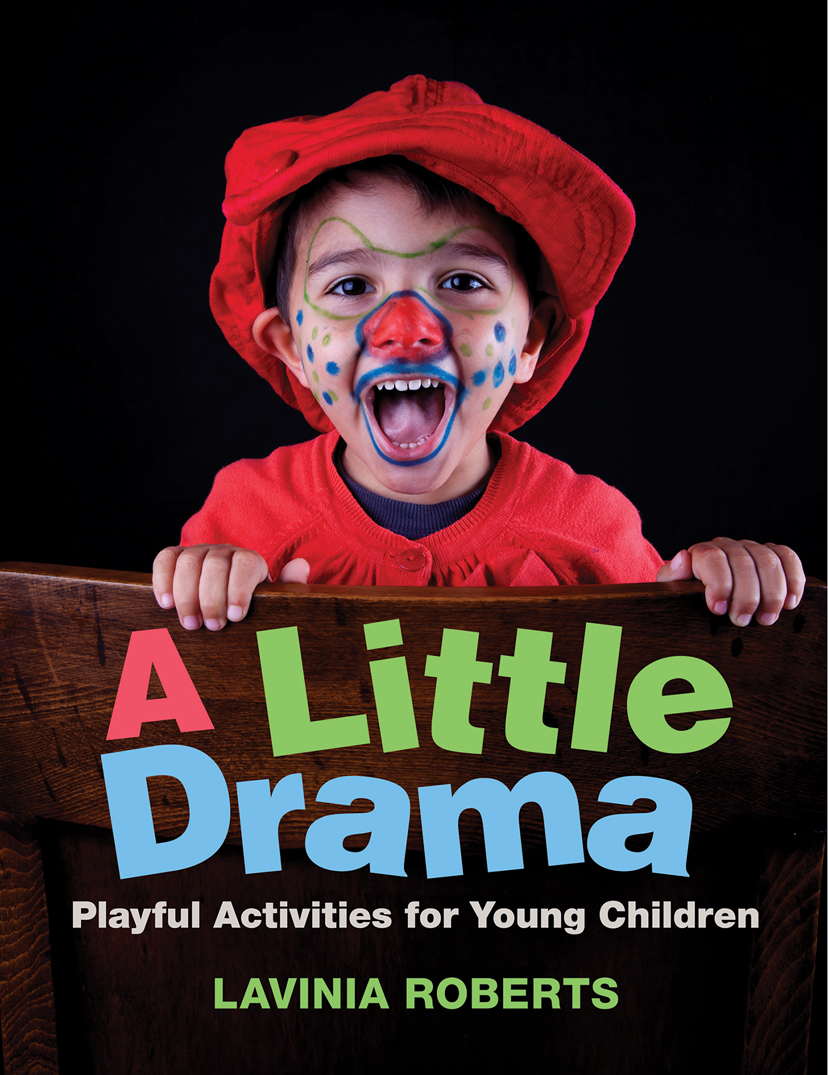Table of Contents
Guide

Published by Redleaf Press
10 Yorkton Court
St. Paul, MN 55117
www.redleafpress.org
2018 by Lavinia Roberts
All rights reserved. Unless otherwise noted on a specific page, no portion of this publication may be reproduced or transmitted in any form or by any means, electronic or mechanical, including photocopying, recording, or capturing on any information storage and retrieval system, without permission in writing from the publisher, except by a reviewer, who may quote brief passages in a critical article or review to be printed in a magazine or newspaper, or electronically transmitted on radio, television, or the Internet.
First edition 2018
Cover design by Erin Kirk New
Cover photographs by ozenli/iStock
Interior design by Louise OFarrell
Typeset in Chaparral Pro
Interior photos by Tom Martin
25 24 23 22 21 20 19 18 1 2 3 4 5 6 7 8
Library of Congress Cataloging-in-Publication Data
Names: Roberts, Lavinia, author.
Title: A little drama!: playful activities for young children / Lavinia Roberts.
Description: First edition. | St. Paul, MN: Redleaf Press, 2018 | Includes bibliographical references.
Identifiers: LCCN 2017056136 (print) | LCCN 2018016166 (ebook) | ISBN 9781605545868 (ebook)
Subjects: LCSH: DramaStudy and teaching (Early childhood)
Classification: LCC PN1701 (ebook) | LCC PN1701 .R57 2018 (print) | DDC 372.66/044dc23
LC record available at https://lccn.loc.gov/2017056136
To
Jennifer Van Bruggen Hamilton and the Topeka Civic Theatre
William Inge Center for the Arts
Wendy Barrie and the community of Trinity Wall Street Parish
ArtsConnection & ProjectArt
Behind every great teacher are great teachers. Special thanks to
Dr. David Montgomery, Tony Graham, Dr. Nancy Smithner,
Regina Ross, Ralph Lee, Dr. Amy Cordileone, Dr. Daphnie Sirce,
Javier Cardona, James Miles, and Alexander Santiago-Jirau
My loving parents, Mary and Richard Roberts, who nurtured
my love of the arts and helped me become the educator
and artist I am today
Contents





I first taught early childhood education at Topeka Civic Theatre and Academy in Topeka, Kansas, one of the largest community theatres in the country. We created storybook dramas based on folktales from around the world, such as Jabut, the tortoise from the Amazon basin, or mongoose, a trickster from folklore of the Maasai, the indigenous people of Kenya. My teaching practice was dedicated to cultivating the troupes voices, bodies, and hearts, as well as allowing the class to explore and play in the world of the folktale. I deeply appreciated how exuberant and willing to be creative these young actors were, and this experience began my love of working in early childhood education.
My passion for creating theatre with young people brought me to New York City to pursue graduate studies in Theatre Education for Colleges and Communities from New York University. I have continued to develop my teaching practice, teaching both visual art and theatre in child care centers, churches, professional theatres, art centers, and public and private schools. I have worked with such arts organizations as Wingspan Arts, ProjectArt, the Childrens Art Guild, Writers Theatre of New Jersey, Urban Arts Partnership, ArtsConnection, and others. I have taught toddlers to adults, but I continue to love creating work with very young children.
While teaching in early childhood spaces, I noticed the lack of drama programs in New York City in both public and private schools. Many had a drama center as part of their classroom centers, which allowed child-initiated dramatic play. Yet few used drama to teach curriculum or had community-created and community-centered drama activities as an active part of their curriculum.
As an educator who was teaching drama to young children, I was also startled by the lack of activity books and resources for teaching drama to young children. Many contained wonderful pedagogy but lacked activities and practical advice for implementing dramatic activities in an early childhood space.
I knew that I wanted to write a book for busy educators, especially those without a theatre background, about how to incorporate drama in their early childhood classrooms. I wanted a book where a teacher could easily find a drama activity or create an entire drama lesson to teach whatever topic the children were learning about in school. A book where teachers could easily find what they were looking for.
I have a multidisciplinary approach to teaching theatre, one that incorporates elements of visual art, yoga, music, and dance. People learn in different ways, and there is immense value to exploring a topic using various art forms. Yoga can be a wonderful way to focus the class and warm up the body for drama play or cool down the body at the end of a drama class. Music can help set the mood or environment of a dramatic activity. Creating sets, puppets, and costume pieces for drama class during art class will bring the drama even more to life for young children. Creative movement ignites the imagination and helps the body create a new vocabulary of expressive movements while developing gross-motor skills.
I hope that my curriculum and teaching pedagogy will nurture, empower, and ignite your imagination and those of the young people you teach.

Including dramatic play in an early childhood classroom is extremely nurturing to the social, emotional, and physical development of young children. Drama is an exciting way to teach children and can be incorporated into other subjects such as reading, science, music, and visual art. Drama classes are also a wonderful way to develop a nurturing and supportive community in your classroom. Including drama in your curriculum also promotes self-expression and develops empathy. Drama is a wonderful tool to nurture the minds, bodies, and hearts of young children.
Social Development
Whether playing a drama game as an entire class or in small groups during centers, theatre promotes prosocial behaviors in young children. Prosocial behaviors can be divided into three main categories: sharing, helping, and cooperation. Displaying sympathy and kindness, positive verbal and physical contact, and empathy are also important prosocial behaviors (Preusse, accessed 2017).









